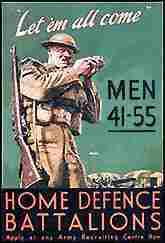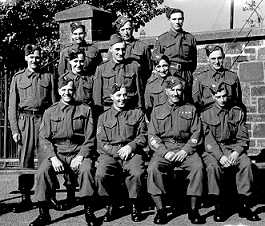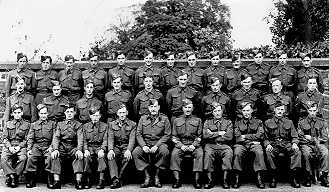

|
At the beginning of the Second World War, a large number of middle-aged men volunteered for war service. In October 1939, Winston Churchill suggested to Sir John Anderson, then head of Air Raid Precautions (ARP), that a Home Guard of men aged over forty should be formed. Anderson agreed with Churchill's suggestion, and after the German Army had launched its Western Offensive in May, 1940, Anthony Eden appealed on radio for men to become Local Defence Volunteers (LDV), the original name of the Home Guard. In July 1940, the name was changed from 'Local Defence Volunteers' to 'Home Guard' on the instructions of Winston Churchill, who felt that the original name was uninspiring. On the night of 14th May 1940, Anthony Eden made his first speech as Secretary of State for War. Part of this speech was asking for volunteers for the LDV:
In the broadcast Eden asked that volunteers should be aged be aged between 40 and 65 and should be able to fire a rifle or shotgun, and the government expected 150,000 men to volunteer. Within 24 hours of the broadcast, 250,000 men had put down their names and by the end of May 1940 the number was between 300,000 and 400,000. By the end of June, 1940 the number of volunteers was just under 1½ million. The public were invited to give their shotguns and pistols to the Home Guard and within a few months over 20,000 weapons were handed in. There was still not enough guns to go around and LDV's carried pickaxes, crowbars, coshes, spears and dummy rifles on duty. The men were also instructed on how to make Molotov cocktails that could be used against German tanks during the expected invasion. They were also trained in sabotage and the use of high explosives. Uniforms began arriving in the autumn of 1940. Some got khaki serge battledress whereas others had to wear LDV armbands. Later the men were issued with steel helmets, greatcoats and waterproof capes. After the defeat of France in June 1940, thousands of LDV's were deployed along the coast of Britain. They were also used to defend ammunition factories. At this time only one in ten was armed with a rifle. These were Lee Enfield rifles that had been used in the First World War. The expected invasion never came, and the main role of the Home Guard was capturing German airmen whose planes had been shot down over Britain. As well as guarding ammunition factories and aerodromes, the men also organised roadblocks and checked people's identity cards.
A large number of members of the Home Guard were amateurs, having no previous military experience. There was also a large wealth of experience within the Home Guard in 1940 and 1941, approximately 40% of volunteers were World War One veterans. The Witheridge platoon began in 1940 as the local Defence Volunteers (LDV), with their headquarters in the Chemist's shop. When they were first formed, their equipment consisted of armbands, shotguns, and pitchforks. (CG) recalls a Colonel Phillips from Adworthy was in charge, and that "he was getting on," She also recalls that they exercised on Sunday mornings, and that she acted as a telephone operator at Newhouse. A retired Major, living at Westway, acted as the Quartermaster Sergeant. Later they were better armed, better than they new on one occasion. One Sunday they were issued with live ammunition instead of blank without knowing it. "We had drawn ammunition for an exercise between two Home Guards over Pedlay and Stockham, and we could not understand why the others kept running away. Then we saw the bushes and twigs being mown down, and a bicycle saddle pillar got shot through."
On another occasion, whilst training on the range at Puddington, someone dropped a live grenade with the pin out, and the Sergeant Major had to pick it up and throw it away. In addition to their normal training, and more local duties, they sometimes did searchlight duties at Venhay Down Cross to allow the army searchlight crews some relief. This point was on the German bombers route to Swansea and Liverpool, and it was the crew's task to hold an enemy bomber in its beam long enough for a fighter plane to shoot it down. At that time there were no anti-aircraft guns nearby. (AB) was in the Nomansland platoon that had their hut at Menchine. Once Ivan Nott and Ted Gillbard were on guard and a chap came along on a bike. "Halt, who goes there?" and they marched him in at bayonet point so that he could produce his identity card and nearly frightened him to death. (OV) Once in the 1939-45 war, the Home Guard arranged a practice spy hunt and Joe Churchill was up in "Cox's Attic" in Mill Cottages watching out, and saw a stranger walking around the police station and thought he was a "Fifth Column" and threw Mr Cox's seed potatoes at him from the attic window shouting "there y'are, ye're dead, yer bugger." Previous Last Edited 03/07/2006 Copyright © 2000-2006 Witheridge Unless otherwise indicated on the page in question, the photographic images reproduced on this site belong to the Witheridge Archives, and, as such may not be reproduced for commercial purposes without written permission. However, you are welcome to use any of the photographs belonging to the archive for personal and/or non-commercial use. Any material shown as not being owned by the archive may not be reproduced in any form without first receiving written permission from the owner of the material in question. |




